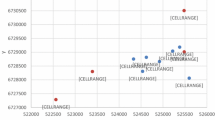Abstract
Capacitive resistive models (CRMs) are a group of simplified mathematical models (proxy models) based on the material balance equation, which allow solving various practical problems that arise during the development of oil fields. An important limitation of traditional CRMs, which significantly narrows the range of tasks that can be solved, is the inability to account for changes in the water saturation of rocks, which limits their applicability only to periods with a high water content of the well’s products. This article presents the author’s new CRM-like model that does not have this disadvantage. An algorithm for adapting such a model is also proposed. The results of numerical experiments on synthetic hydrodynamic models demonstrating a better quality of solutions compared to the CRMP are presented.




Similar content being viewed by others
REFERENCES
T. A. Pospelova, S. V. Stepanov, A. V. Strekalov, and S. V. Sokolov, Mathematical Modeling for Decision-Making on Field Development (Nedra, Moscow, 2021) [in Russian].
T. A. Pospelova, D. V. Zelenin, A. A. Ruchkin, and A. D. Bekman, “Application of CRM models for analysis of waterflood performance,” Neft. Prov., No. 1, 97–108 (2020). https://doi.org/https://doi.org/10.25689/NP.2020.1.97-108
M. Sayarpour, Development and application of capacitance–resistive models to water/CO2 Floods, PhD Dissertation (University of Texas, Austin, TX, USA, 2008). https://doi.org/10.13140/RG.2.1.1798.3847
N. O. Shevtsov and S. V. Stepanov, “Development of the material balance model to account for changes in the well productivity index,” Math. Models Comput. Simul. 14, 691–699 (2022). https://doi.org/10.1134/S2070048222050131
F. Cao, Development of a two-phase flow coupled capacitance resistance model, PhD Dissertation (University of Texas, Austin, TX, USA, 2014).
A. D. Bekman, S. V. Stepanov, A. A. Ruchkin, and D. V. Zelenin, “A new algorithm for finding CRM-model coefficients,” Vestn. Tyumen. Gos. Univ. Fiz.-Mat. Model. Neft’, Gaz, Energ. 5 (3), 164–185 (2019). https://doi.org/10.21684/2411-7978-2019-5-3-164-185
A. D. Bekman and D. V. Zelenin, “Application of advanced CRMP for reservoir pressure mapping,” Vestn. Tyumen. Gos. Univ. Fiz.–Mat. Model. Neft’, Gaz, Energ. 7, 163–180 (2021). https://doi.org/10.21684/2411-7978-2021-7-4-163-180
R. H. Brooks and T. Corey, “Hydraulic properties of porous media,” Hydrology Papers, No. 3 (Colorado State University, Fort Collins, CO, USA, 1964).
Author information
Authors and Affiliations
Corresponding author
Ethics declarations
The author declares that he has no conflicts of interest.
Rights and permissions
About this article
Cite this article
Bekman, A.D. The New CRM-Like Two-Phase Proxy Model for the Oil Field Development Process. Math Models Comput Simul 15, 999–1007 (2023). https://doi.org/10.1134/S2070048223060078
Received:
Revised:
Accepted:
Published:
Issue Date:
DOI: https://doi.org/10.1134/S2070048223060078




